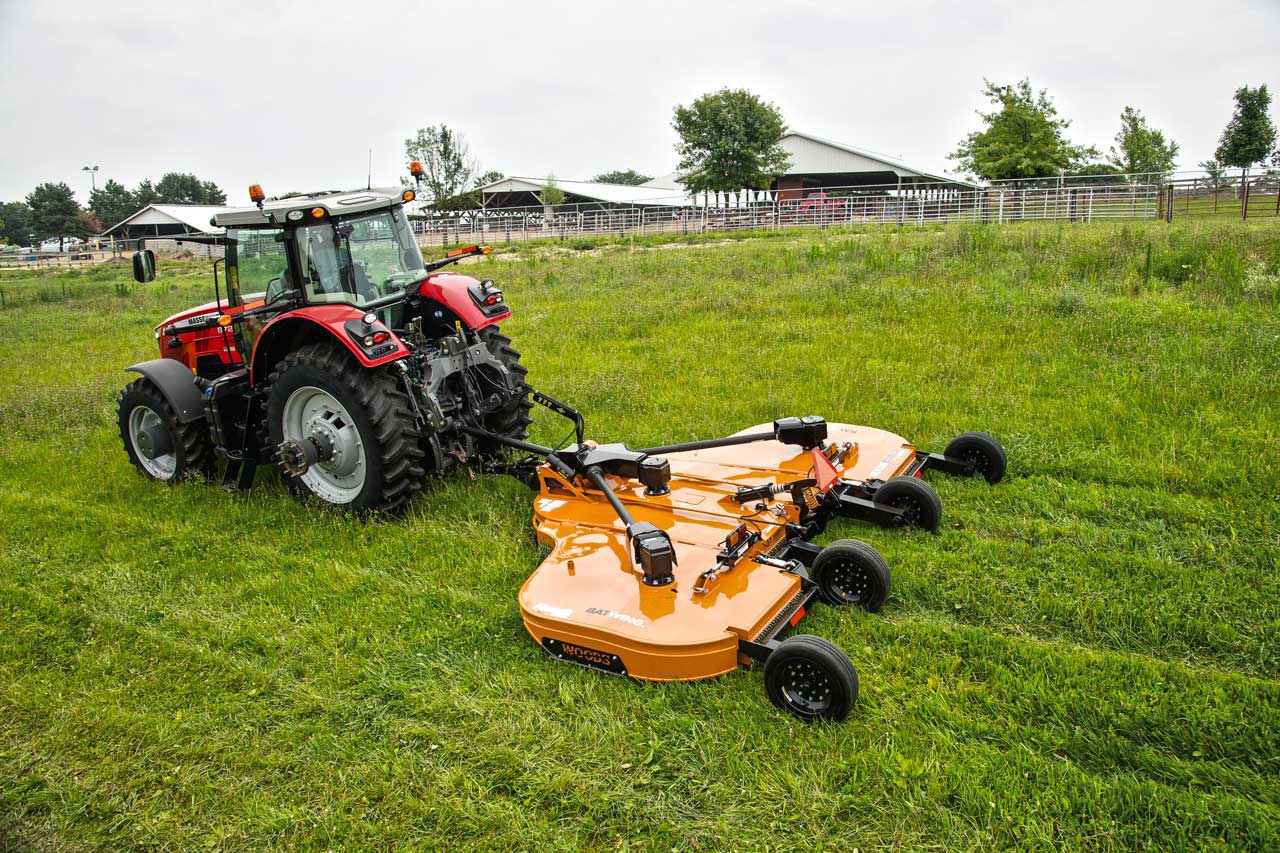Introduction
Vegetation management is an important aspect of sustainable land management, and is necessary to ensure public safety, prevent wildfires, and promote healthy ecosystems. One of the most common methods of vegetation management is slashing, which involves cutting down overgrown vegetation using a slasher. While slashing can be an effective way to manage vegetation, using a slasher that leaves windrows of cut vegetation behind can have negative consequences. In this blog post, we’ll discuss the benefits of not leaving a windrow when slashing, including pasture management, enhancing soil health, reducing fire risk, improving aesthetics, creating habitats for wildlife, and making maintenance easier. A Woods slasher will not leave a windrow, spreading the material behind the slasher similar to a mulcher.
Pasture Management
Not leaving a windrow when slashing can have positive effects on pasture management. Windrows prevent the pasture from growing efficiently, thereby reducing the productive capacity of your land. When you slash weeds and other pasture with a slasher that does not leave a windrow (such as a Woods slasher), your pasture has a chance to fully recover with new growth that efficiently covers the ground allowing you to ensure you are increasing the pasture production on your land.
Pastures with windrows can be difficult to navigate, especially for livestock. Windrows can create barriers that prevent animals from accessing the grass and water they need, which can lead to decreased weight gain and overall health. By slashing with a Woods slasher and spreading the cut material evenly across the ground, you can make it easier for livestock to move around and access the resources they need. This can lead to increased weight gain, improved animal health, and increased productivity for primary producers.
“I’VE REDUCED MY SLASHING TIME IN HALF FORM 30 HOURS TO 15 HOURS A WEEK. EVEN WHEN SLASHING IN HEAVY MATERIAL NOTHING IS LEFT BEHIND, GIVING MY ORCHARD A MOWER FINISH AND NICELY DISCHARGING MATERIAL UNDER MY TREES. WOODS ARE WELL BUILT MACHINES.”
Mark Taylor – Orchardist and Woods Owner
Better Soil Health
Windrows can trap moisture and prevent it from reaching the soil, which can have negative effects on soil health. This can lead to decreased plant growth and biodiversity in the area. When you don’t leave a windrow when slashing with a Woods slasher, you allow the soil to receive moisture and nutrients, which can help support healthy plant growth. This, in turn, can improve the overall health of the ecosystem. Improved soil health can also lead to better water quality, erosion control, and increased carbon sequestration; ultimately more return on your land.
Reduced Fire Risk
Leaving a windrow behind can increase the risk of fire. Windrows can dry out and become fuel for accidental fires, especially during hot and dry weather conditions. If the windrow is near buildings or infrastructure, the risk of fire can be even higher. By clearing all the cut vegetation and not leaving any windrows behind when slashing, you can help reduce the risk of fires. This can prevent property damage, loss of wildlife habitat, and even save lives.
Easier Maintenance
Windrows can be difficult to remove, especially if they’re large or in hard-to-reach areas. They can also interfere with future landscaping or planting efforts, making it harder to achieve the desired look for the area. By spreading the cut material out evenly behind your Woods slasher, you can make maintenance easier and more efficient. This can save time and money for the organisation responsible for maintaining the area. It can also make it easier to identify and address any future issues, such as invasive species or diseased plants.
Improved Habitat for Wildlife
Clearing the cut vegetation can create new habitats for wildlife, such as small mammals and insects, which can make the area more biodiverse. Leaving windrows when slashing can actually harm wildlife, as it can create barriers that prevent them from accessing food, water, and shelter. Windrows can also attract unwanted pests, such as rodents and insects, which can have negative effects on the ecosystem. By clearing all the cut vegetation with a Woods slasher, you can create a more hospitable environment for wildlife, which can lead to increased biodiversity and ecosystem health.
Improved Aesthetics
Windrows can make the area look untidy and unattractive, especially in highly visible areas such as parks, roadways, and recreational areas. Windrows can also interfere with future landscaping or planting efforts, making it harder to achieve the desired look for the area. By clearing all the cut vegetation, you can improve the overall appearance of the area and make it easier to maintain in the future. This can improve the public’s perception of the area, increase tourism, and even lead to higher property values.
Conclusion
Clearing all the cut vegetation and not leaving a windrow behind can have numerous benefits for vegetation management, including reduced fire risk, improved aesthetics, enhanced soil health, and increased wildlife habitat. It can also make maintenance easier and more efficient, and lead to increased productivity for farmers. By considering these benefits, we can make more informed decisions when managing vegetation and promoting sustainable land management practices. A Woods slasher will not leave a windrow and will spread the cut vegetation out behind the slasher, making Woods the superior slasher to partner with in your paddocks.

